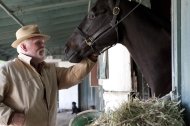A doctor checks a child at Kantha
A woman pulls a child on a gurney
Children and their parents at Kantha
It's not bird flu or SARS, and
nor does it appear to be contagious, but little more is known about a mysterious
disease that has killed dozens of Cambodian children, some within 24 hours of
being hospitalised.
Medical experts are scrambling to respond
to what the Cambodian health ministry and World Health Organization (WHO) have
labelled an "undiagnosed syndrome" that has claimed the lives of at least 56
boys and girls, mostly toddlers, since April.
Officials said just one child was believed
to have survived the illness and the high fatality rate has
spread concern among Cambodians, 30 percent of whom live below the poverty line
according to the World Bank.
The WHO has put neighbouring countries on alert about the killer disease,
that starts with a high fever and is followed by respiratory and neurologic
symptoms "with rapid deterioration of respiratory functions".
There have been no cases reported outside
Cambodia so
far.
"We are looking at detailed information
from the hospital records and analysing each and every case. We hope to have a
better picture in the coming days," said Ly Sovann, deputy director of
Cambodia's Communicable
Disease Control Department in a joint statement with the WHO on
Friday.
Paediatrician Beat Richner, the founder of
Kantha Bopha
children's hospitals, which see around 85 percent of Cambodia's severely ill
youngsters who make it to treatment, was the first to raise the alert over the
illness.
The Swiss doctor, who told Cambodian health officials about the illness last
month, gave a higher toll than the WHO, saying 64 children had died from the
disease since mid-April, while two more had recovered.
The victims were aged seven and under with
most being between two and three years old, Richner told AFP in an interview.
The most recent death was on Saturday.
"All these children have encephalitis (inflammation of the brain) and in the
later hours of their life they develop a severe pneumonia with a destruction of
the alveoli in the lungs. That is the reason they die," he said.
The alveoli, or air sacs, are pockets in
the lungs where the exchange of oxygen and carbon dioxide takes place.
"We think it's either a virus, an intoxication, or both," Richner said.
While it is impossible to rule out
contagion at this early stage, Richner said he had yet to come across two cases
in the same family, and no health workers appear to have fallen ill after caring
for the patients.
The WHO has also said it has found no clusters, though most of the patients
came from central and southern parts of Cambodia.
Like the WHO and the health ministry,
Richner's staff are racing to find the cause of the disease, sending blood and
tissue samples to the Institut Pasteur -- a renowned infectious disease research
centre.
Early results from a selection of those
samples show some of the children had been infected by a lethal strain of hand, foot and mouth
disease, although Richner said more analysis was needed.
He said all the patients who died were
treated in private clinics in their local areas before being brought to the
Kantha Bopha hospitals in the capital and the northwestern province of Siem
Reap.
"They all got injections or infusions by private carers before coming to us,"
he said. "Some died four hours after arriving."
From his own figures, Richer said the two
patients that lived were treated only by Kantha Bopha staff, suggesting that
botched medical treatment may be a factor.
The WHO said it was too soon to draw conclusions.
"We are looking at the possibility of this
being something new, a collation of different diseases with similar clinical
presentations but caused by a different pathogen," said doctor Nima Asgari, a
public health specialist at the WHO office in Cambodia.
The UN health body and Cambodian officials have urged parents to bring their
sick children to hospital if they see any signs of "unusual illness".
Joining the daily queues of hundreds of
families seeking treatment at Kantha Bopha, In Sitha said she first heard about
the mystery illness while her three-year-old son was in hospital with pneumonia
last month.
"I heard it develops very fast," she said. "As a mother, I feel very scared
and helpless about this. I just hope this unknown disease can be cured so that
my son and other people's children can survive."Richner urged parents to stay calm saying "there's no reason for hysteria," and pointed out that an ongoing dengue fever epidemic was a much larger worry.
In June alone, more than 5,000 children
were hospitalised with haemorrhagic dengue fever, compared to just 34 cases of
the unknown disease. "That's the big problem," Richner said.
--------------------------------------------------------------------------
I'm just saying, it could be really dangerous. I guess we will have to wait and see what happens with it.
--------------------------------------------------------------------------
I'm just saying, it could be really dangerous. I guess we will have to wait and see what happens with it.








 If you look closely, the titles of these new scents are things like Man Town, 2x4, and Riding Mower.
If you look closely, the titles of these new scents are things like Man Town, 2x4, and Riding Mower.








